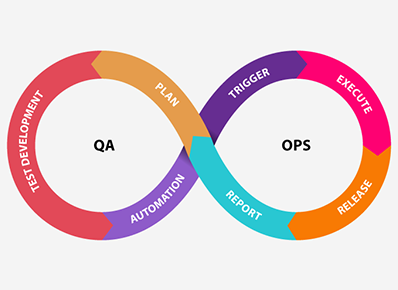Basically QAOps refers to maintaining the quality of a software by addressing it with DevOps mindset. We might have come across the label “DevOps” and it refers to Development (Dev) and IT operations(Ops).
“Devops” might find it difficult to deliver the project on time with neglecting the software quality. That’s where QAOps comes into picture for timely delivery of quality software.
QAOps framework is a new flavor of DevOps to bring the QA and software operations together as a business practice. Generally Software Development Life Cycle includes QA at the end but QAOps recommends to integrate testing and QA right from the beginning to the ending phase, which may result in identifying bugs and producing error-free development cycles.
Life Cycle of QAOps:
As mentioned earlier QAOps highly recommends continuous testing like CI/CD. It consists of 3 phases:
1.Trigger : The important step of QA is to trigger the relevant tests whenever the functionality changes are made in the CI/CD pipeline.
The test has to be triggered only based on the changes made on functionality else we might lose the precious time in testing the inappropriate areas where the changes are not made.
2. Execute : The parallel tests are executed in this phase which were approved in the trigger phase to ensure the product quality.
3. Report : The reporting phase kicks in once the tests are triggered and executed.This module showcases the result of the entire process, we should make sure to design the reporting module precisely to make QAOps process efficient and to provide quick summary information.
Methodologies of QAOps frameWork
- Automated Testing : One of the main pillars of QAOPs framework. Automating testing is utilizing technology and tools to perform tests. It allows QA engineers to test the product at a faster pace.
- Parallel testing : To reduce the overall testing time the test code should be executed simultaneously. Running parallel automated tests would directly affect the delivery process by speeding up the testing process. Although it helps in enabling faster testing it also requires more computation power and hardware capabilities.
- Scalability testing: This type of testing helps in determining the software performance by modifying the test load at various conditions and renders the software behavior when the usage will decrease and increase ultimately. As after every release the application continues to scale the testing routine should also be scaled along with the CI/CD pipeline. This testing will also help QA in revealing the performance related challenges of the application.
Benefits of QAOps
- Helps in providing premium products compared to traditional methodology.
- Additional to the quality this will also help in delivering the software with a predefined deadline.
- Empower in eliminating the ambivalence between different teams by allowing development and QA to work coordinately.
- Helps in identifying the errors and bugs at the early stage which provides reliable products.

